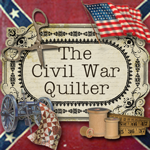A friend asked me recently how I could get so excited about quilt history. To her the color and design of quilts is what excited her, as well as the connection to the person to whom she was going to give the quilt, not necessarily the history of quilts in general. I had to really ponder her question.
I love the color and the design as well. But I also love the "connectedness" of quilts. All quilts ultimately contain a story. It's just that most of them we will never know. But its ferreting out the leads, however small, that intrigues me.
These are objects made by women for the most part and they are powerful contextual carries of women's history as well as community history. They were the voice of women long before most women were allowed to have a voice in public matters.
Several blogs have written about an image similar to the one above found on a quilt from the 1850s. Barbara Brackman's blog adds background material to the story. A silk quilt made by Quaker activist Deborah Coates's pictured in the book Heart and Hands: Women, Quilts, and American Society, was cut in half for two descendants and the image of the chained slave discovered by a future generation.
The threaded needle was also a vehicle of livelihood for women in the 1800s when there were few options available.
Quilts reflect the various eras of art history as well as changing social values. They also reflect and document Western societies' shift in attitudes and perceptions of children and childhood. The illustrations of author Kate Greenway were some of the first images of children translated into needlework patterns and one can trace children's dress, games and moral education thru quilt patterns.
Quilts came into their own as vehicles of community fund raising in the 1800s and, as a consequence, bear the signatures of thousands of women and other community members. One will soon discover upon acquiring a Signature Quilt that one can actually tease out the stories of these lives thru diligently digging into historical records. And one will be astounded at the millions of dollars that have been raised thru Fund Raising Quilts since the early 1800s to this day.
These are objects made by women for the most part and they are powerful contextual carries of women's history as well as community history. They were the voice of women long before most women were allowed to have a voice in public matters.
Several blogs have written about an image similar to the one above found on a quilt from the 1850s. Barbara Brackman's blog adds background material to the story. A silk quilt made by Quaker activist Deborah Coates's pictured in the book Heart and Hands: Women, Quilts, and American Society, was cut in half for two descendants and the image of the chained slave discovered by a future generation.
The threaded needle was also a vehicle of livelihood for women in the 1800s when there were few options available.
Quilts reflect the various eras of art history as well as changing social values. They also reflect and document Western societies' shift in attitudes and perceptions of children and childhood. The illustrations of author Kate Greenway were some of the first images of children translated into needlework patterns and one can trace children's dress, games and moral education thru quilt patterns.
Quilts came into their own as vehicles of community fund raising in the 1800s and, as a consequence, bear the signatures of thousands of women and other community members. One will soon discover upon acquiring a Signature Quilt that one can actually tease out the stories of these lives thru diligently digging into historical records. And one will be astounded at the millions of dollars that have been raised thru Fund Raising Quilts since the early 1800s to this day.
Quilts have literally helped make sense out of world history for me and the pursuit of this passion has led to friendships all over the world.
What is your passion?
Cheers,
Karen
What is your passion?
Cheers,
Karen













History is such a part of our lives. I find it hard to believe that so many people regard it as "unimportant". I admire researchers and hope to someday have more time to focus on it as well. Thanks for all you do to bring quilt history to the forefront. By the way, I love that photograph. I am wondering if someone simply hung their coat on that picture or if they were covering it up on purpose. I love old photos and mysteries! Happy Thanksgiving.
ReplyDeleteThank you, Wendy, for stopping by to read and for taking time to comment. I wish I had the self-discipline to blog more often. I really groove on history and go down rabbit holes every day trying to track down clues.
ReplyDeleteI'm thrilled that you and others have gone down those rabbit holes and shared your findings with us. As an immigrant to the USA, I've learned so much US history through quilts. Happy Thanksgiving
ReplyDeleteI have found when people see antique quilts they are surprised by the color and design. Too often they were exposed to very brown inaccurate reproduction styled quilts. I enjoy all aspects of quilting, but history is my passion.
ReplyDeleteLet's keep sharing!